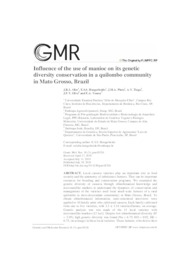Influence of the use of manioc on its genetic diversity conservation in a quilombo community in Mato Grosso, Brazil.
Influence of the use of manioc on its genetic diversity conservation in a quilombo community in Mato Grosso, Brazil.
Autoria: OLER, J. R. L.; HOOGERHEIDE, E. S. S.; PINTO, J. M. A.; TIAGO, A. V.; SILVA, J. F. V.; VEASEY, E. ANN
Resumo: Local cassava varieties play an important role in food security and the autonomy of subsistence farmers. They can be important resources for breeding and conservation programs. We examined the genetic diversity of cassava through ethnobotanical knowledge and microsatellite markers to understand the dynamics of conservation and management of the varieties used local small-scale farmers of a rural quilombo (a slave-descendant community) in Mato Grosso, Brazil. To obtain ethnobotanical information, semi-structured interviews were applied to 10 family units who cultivated cassava. Each family cultivated from one to five varieties, with 2.3 ± 1.16 varieties/farmer, on average. Genetic analysis was was made of the 11 local varieties with microsatellite markers (12 loci). Despite low ethnobotanical diversity (H' = 2.05), high genetic diversity was found (Na = 6.75, HO = 0.92, HE = 0.75, on average) in these local varieties. These farmers, who derive their income mainly from cassava cultivation and flour production for the market, direct their variety choices to those that are most productive. Brava variety was the most frequent (found in eight family units) and was considered the most profitable for the production of flour Network analysis showed that propagule circulation and information occurs between the residents and also with other communities of the region, which are important sources of new varieties. Two farmers were identified as the most active in this network, showing potential as key elements for the circulation of propagating material. According to the cluster analysis using the genetic data, the most recently introduced varieties (Baixinha, Liberatona, Broto roxo, Mansa, Ramo branco, Carneiro and Cuiabana) are separated from those introduced a long time ago. The varieties pointed out as bitter by the farmers were also grouped together. The results showed the importance of traditional farmers in maintaining a high genetic diversity of manioc varieties, despite the directing of the choice of varieties to meet market needs.
Ano de publicação: 2019
Tipo de publicação: Artigo de periódico
Unidade: Embrapa Agrossilvipastoril
Palavras-chave: Biodiversity, Ethnobotany, On-farm conservation
Observações
1 - Por padrão são exibidas publicações dos últimos 20 anos. Para encontrar publicações mais antigas, configure o filtro ano de publicação, colocando o ano a partir do qual você deseja encontrar publicações. O filtro está na coluna da esquerda na busca acima.
2 - Para ler algumas publicações da Embrapa (apenas as que estão em formato ePub), é necessário ter, no celular ou computador, um desses softwares gratuitos. Sistemas Android: Google Play Livros; IOS: iBooks; Windows e Linux: software Calibre.
Acesse outras publicações
Acesse a Base de Dados da Pesquisa Agropecuária (BDPA) para consultar o acervo completo das bibliotecas da Embrapa.

